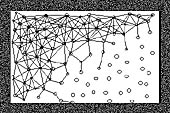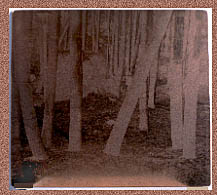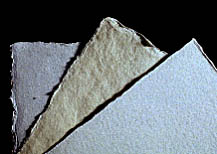For more information, visit www.kamprint.com
Prints are made in limited editions from inked plates pressed against special papers. With woodcuts and lithographs, the ink is transferred from a raised or treated surface. To make an etching, ink from the incised lines or points of a copperplate is pressed into specially prepared etching paper while the copperplate travels on a bed between the two rollers of the etching press. Gravure prints, also known as photogravure, heliogravure, or gravure a l'aquatinte, are a type of etching with aquatint ~ where the image is created from a photographic source and realized in permanent ink on paper. The aquatint ground, consisting of very fine asphaltum particles fused to the copperplate, creates minute unetched 'lands.' In the crevices between these 'lands,' ink remains and forms the image in a variety of tones corresponding to the depth of etching.
The variable depth of the etched copperplate is one of the unique qualities of a gravure print. This is made possible by the use of sensitized gelatin as an etching resist. Etching resists are usually binary ~ they either resist the etchant completely or, where incised by lines, allow etching to occur unimpeded. But gelatin absorbs the etchant and allows it to seep through to the copperplate. The thinner resist allows etchant to seep through first and etch deepest ~ these areas correspond to the darkest areas of the image. Thicker resist holds the etchant back longer, so that only light etching occurs. By moving the plate through various etching baths, it is possible to adjust how deeply each tone is etched in relation to other tones. The illustration shows an enlarged cross-section of the copperplate ready for etching, with aquatint grain (black dots) fused to the plate and the permeable gelatin resist (bright orange) above that.

Pre-etch copperplate
How does the resist get thicker or thinner? Ultraviolet light (UV) sets off a chemical reaction that hardens or crystallizes the gelatin. When exposed in contact with a transparency, the highlights admit more UV, the shadows less, and this difference in UV exposure causes different thicknesses in the gelatin.

Cross-linking of UV-exposed gel
The UV-exposed gelatin is adhered to the copperplate, allowed to set, then the unexposed portion is washed off. The resist must dry in a perfectly even way to prevent irregularities in the etching, though there is creative potential. The 'crater' in the surface of one of the Potato Moons, for example, originated from a break in the resist. And the flowing motion in the upper right of Westwind came from the actual flow of an irregularly drying resist. I plan to explore such effects further in future (Work In Progress).
After drying the resist and masking the plate to confine etching to the image area, etching is done in a series of ferric chloride baths. The first and strongest etches only the shadows but does not penetrate the thicker resist of the midtones and highlights. More dilute etchant, having more water, soaks through the thicker resist and starts etching midtones and highlights in succession. If the resist has been over-exposed, the etchant will never get through to the highlights. But highlight etching, when it occurs, must be brief to retain the impression of sunlight.
After etching, we take a proof and if OK, remove the resist and aquatint grain, and file and bevel the edges of the plate to prepare it for printing on the etching press. Here is the etched copperplate from which the Hokokuji print was made.

Etched plate, Hokokuji
The image is laterally reversed when printing. The dark areas of the copperplate, having been etched as much as 20 or 30 times more deeply than the light areas, hold that much more ink and create superb tonal variety in the print. For each impression, the plate is inked, wiped, and printed on the etching press. This involves clearing the ink from the aquatint 'lands' and image highlights with gradually decreasing wiping pressure. Finally a very light passage over the plate, known as retroussage, and the plate is ready to roll through the press ~ always an exciting moment.
Etching papers differ in how they take the ink, how absorbent they are, tone, and surface texture. I use harder, less absorbent papers such as Lana Gravure and Magnani for lighter images of sand and snow. Deeply etched plates that transfer a lot of ink print well on more absorbent papers such as Fabriano, Kyokushi, or Ganpi. The thinnest Ganpi (middle illustration, front) can be attached to a heavier sheet during printing for a unique gossamer effect. Shown below are some of my favorite etching papers and Japanese washi.



Magnani, Lana, Fabriano, Somerset. . .Ganpi White, Torinoko, Ganpi Cream, Ganpi. . .Tosa Hanga,Mitsumata,Kyokushi
Contact > z3ix@kamprint.com